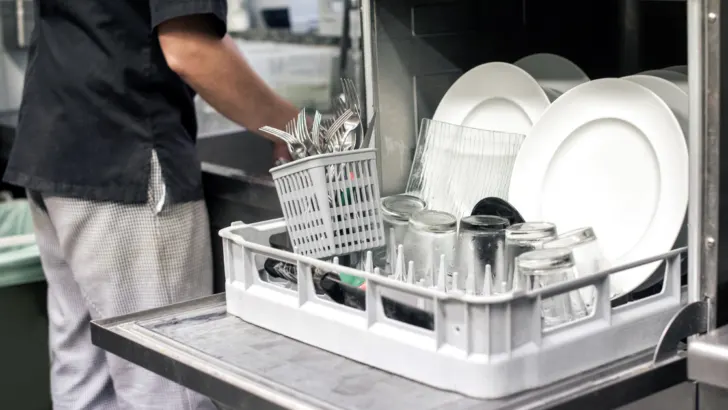Unraveling the Drainage Mystery – KitchenAid Dishwasher Woes
Why Is My Kitchen Aid Dishwasher Not Draining – Unlocking the Mystery
As a homeowner, I take pride in keeping my kitchen appliances in top shape. However, I recently encountered an issue with my Kitchen Aid dishwasher not draining properly. This can be a frustrating problem to deal with, especially when you have a sink full of dirty dishes waiting to be cleaned.
After researching the issue, I discovered that there are various reasons why a Kitchen Aid dishwasher may not be draining properly. In this article, I will share my findings and provide practical solutions to help you resolve this problem.
It is important to note that some of the solutions may require basic plumbing skills. If you are not comfortable working with plumbing, it may be best to seek the assistance of a professional. With that said, let’s dive into the possible causes and solutions for a Kitchen Aid dishwasher not draining.

Dishwasher Drainage Woes – Common Causes and Solutions
Exploring the Depths of Dishwasher Dilemmas: Unveiling the Culprits Behind Non-Draining Woes
The moment my trusty Kitchen Aid dishwasher betrayed its draining efficiency, a cascade of thoughts rushed forth. I found myself in a realm of troubleshooting, where myriad factors danced on the stage of possibilities. Each factor held the potential to unveil the mystery behind the dishwasher’s reluctance to bid adieu to its watery contents. Through this journey, I unearthed a tapestry of distinct culprits, each wielding its influence over the seamless flow of water. Here, I share with you the diverse landscape of challenges that can hinder a dishwasher’s draining prowess, and the steps I undertook to restore its harmonious operation.
- Clogged Drain Intake: As I delved into the realm of dishwasher drainage woes, a frequent culprit emerged – a clogged drain intake. Food, those delightful remnants of culinary endeavors, often found their way into the drain, creating a blockade that thwarted the water’s exit. A meticulous inspection led me to the heart of the drain, where I encountered an accumulation of food debris. With careful hands, I embarked on a journey of dislodging and extracting, clearing the path for water to once again flow freely.
- Faulty Pump or Motor: The heartbeat of a dishwasher resides in its pump and motor, orchestrating the expulsion of water. A faltering pump or motor can disrupt this symphony, resulting in stagnation. Armed with determination, I ventured into the inner workings of the dishwasher, scrutinizing the pump and motor for signs of wear or malfunction. My vigilance paid off as I identified a faltering motor, swiftly opting for its replacement, ensuring the restoration of the dishwasher’s vigor.
- Clogged Garbage Disposal: A familiar adversary emerged – the clogged garbage disposal. Its insidious presence can cause a blockade in the water’s path, halting its journey to freedom. With an understanding heart, I turned my attention to the disposal unit, unraveling its hidden chambers and dispelling the accumulated debris. The dance of water resumed as the path was once again clear.
- Interrupted Cycle: The dishwasher’s cycle, a choreography of precision, can falter due to unforeseen interruptions. A sudden opening of the dishwasher mid-cycle or a power outage can cast a shadow over the draining process. With resolve, I embarked on a mission to restore order, restarting the dishwasher and allowing it to complete its interrupted cycle, thereby granting the water its rightful passage.
- Kinked Drain Hose: The humble drain hose, a conduit of fluidity, can itself become entangled in the drama. A kink or twist in the hose obstructs the water’s exit, plunging the dishwasher into a non-draining dilemma. With patience and a deft touch, I untangled the hose, liberating it from its inhibiting contortions, thus reinstating its fluid role.
In summation, the perplexing tale of a non-draining Kitchen Aid dishwasher unfolds as a multifaceted narrative. It is a saga where a harmonious choreography can be disrupted by a variety of factors, each demanding its own unique remedy. Through a diligent process of diagnosis and intervention, I was able to pinpoint the underlying issues and apply the appropriate solutions. As the curtain falls on this journey, I stand armed with a newfound understanding and a sense of empowerment, ready to confront any future challenges that may dare to hinder the symphony of my dishwasher’s operation.

When Water Lingers – Troubleshooting Your KitchenAid Dishwasher
How to Troubleshoot a Kitchen Aid Dishwasher That Is Not Draining
If you’re experiencing issues with your Kitchen Aid dishwasher not draining, there are a few things you can do to troubleshoot the problem before calling in a professional. In this section, I will walk you through the steps you can take to identify and fix the issue.
Delving into the Depths of Dishwasher Resilience: Unlocking the Mystery of the Float Switch
In the intricate tapestry of dishwasher mechanics, a humble sentinel stands guard, ready to perform a crucial task – the float switch. Positioned unobtrusively in the front right corner of the dishwasher tub, this unassuming component wields a significant role, one that ensures a delicate equilibrium between function and precaution. It’s the gatekeeper that ensures your dishwasher doesn’t venture into the realm of overfilling, yet its harmonious orchestration can falter over time, causing a cascade of repercussions, most notably an inability to drain properly.
As you embark on the journey of restoring your Kitchen Aid dishwasher’s draining prowess, the float switch emerges as the first checkpoint. This vigilant guardian is often the unsung hero behind the scenes, quietly orchestrating its duties until an imbalance disrupts the symphony.
With the float switch’s significance in mind, it’s time to unveil its presence and ascertain its state. The first order of business is to remove any potential obstacles that may have inadvertently found their way into the float area. As these obstructions are carefully cleared away, the float switch itself beckons your attention.
With a gentle touch and an air of curiosity, you engage in a tactile dialogue with the float. Its movement, an indicator of its responsiveness, is assessed as you guide it through its range of motion – up and down, an elegant ballet within the confines of the dishwasher. The freedom of movement, an affirmation of functionality, sets the stage for a sigh of relief.
Yet, as with any story, a twist may unfurl. The float switch may reveal signs of being caught in a perpetual embrace with the “up” position, a position that signals a dishwashing limbo. In this scenario, where the float’s responsiveness is compromised, the possibility of replacement looms on the horizon, a torchbearer of renewal and restoration.
In your pursuit of dishwasher perfection, the exploration of the float switch becomes a testament to your role as a vigilant steward of your kitchen’s mechanics. As you navigate the intricacies of this component, you embody the spirit of a technician attuned to the harmonious balance between technology and care. With each diagnostic action, you breathe life back into your dishwasher, allowing it to continue its symphony of cleanliness and efficiency. And so, armed with knowledge and equipped with insights, you march forward in your quest for household mastery, assured that the resilience of your dishwasher shall shine bright once more.
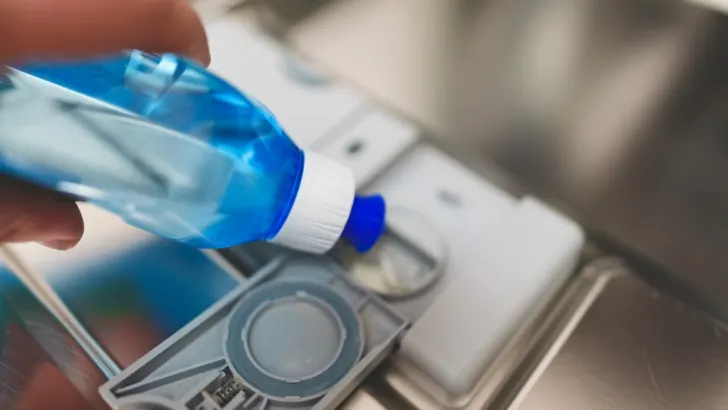
Drainage Disarray – Fixing KitchenAid Dishwasher Drain Issues
Exploring the Depths of Dishwasher Performance: Unveiling the Drain Pump Filter
As we continue our voyage into the realm of dishwasher maintenance, a crucial checkpoint beckons – the drain pump filter. An unsung hero in the saga of cleanliness, this unassuming filter quietly labors behind the scenes, diligently safeguarding the symphony of your dishwasher’s efficiency. Yet, over time, even this steadfast sentinel can fall victim to the accumulations of everyday life – a mosaic of food remnants, greasy residues, and assorted debris. When left unchecked, these elements converge to orchestrate a silent uprising, causing disruptions in the harmonious drainage process.
With your diligent examination of the float switch complete, it’s the drain pump filter that now claims your attention. Nestled within the dishwasher’s heart, this filter assembly holds the key to uninterrupted drainage. A tapestry woven with the remnants of countless meals, it is not immune to the gradual build up that time imposes.
As you embark on this quest, begin by ushering forth the bottom rack, revealing the concealed sanctuary of the filter assembly. A delicate balance of anticipation and curiosity guides your actions as you lay bare the filter’s domain. What meets your gaze might be an ensemble of food fragments, an amalgamation of grease, and perhaps even the remnants of culinary adventures that have faded into memory.
With determination and purpose, these elements are carefully coaxed away, making way for a thorough cleansing ritual. Warm, soapy water becomes your trusted ally, diligently cleansing the filter of its burdens. The filter’s intricate contours, a testament to its dedicated service, are meticulously attended to, ensuring every nook and cranny is restored to pristine condition.
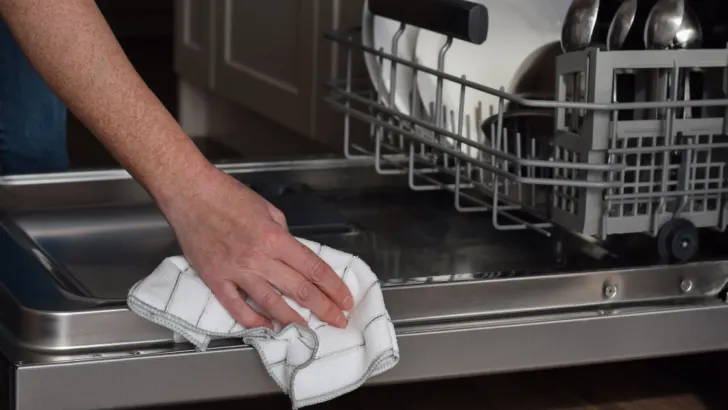
Why Won’t My Dishwasher Drain – Exploring KitchenAid Woes
However, in the tapestry of maintenance, a fragment may show signs of vulnerability. A filter that has borne the weight of its duties might exhibit signs of wear, a testament to its unwavering dedication. In such cases, the prospect of replacement emerges, a renewal that reinstates the filter’s prowess and ensures its role in the grand performance of drainage remains unblemished.
As you embark on the task of exploring the drain pump filter, you not only navigate the mechanisms of your dishwasher but also celebrate your role as a custodian of a well-tuned kitchen orchestra. With each cleansing gesture, you lend your expertise to the symphony of cleanliness, allowing your dishwasher to shine in its intended brilliance. And so, armed with knowledge and fortified with action, you forge ahead in your journey of household mastery, harmonizing the elements of technology and care to orchestrate a symphony of seamless functionality.
Exploring the Drain Hose: A Pathway to Smooth Operation
In our quest to unveil the secrets behind a dishwasher’s seamless functionality, our focus now shifts to a pivotal element – the drain hose. As a silent conduit, this unassuming hose plays a significant role in the intricate choreography of your dishwasher’s performance, ensuring the unobstructed passage of wastewater from its bustling interior to the waiting embrace of the drain.
With the float switch and drain pump filter having been meticulously examined and given a clean bill of health, it is the drain hose that takes center stage. Positioned at the rear of the dishwasher, this unpretentious conduit carries a weighty responsibility. It channels away the remnants of culinary escapades, allowing the dishwasher to maintain its rhythm of cleanliness.

Diving into Drainage Problems – KitchenAid Dishwasher Insights
As the diligent investigator of your kitchen’s mechanical ensemble, your first task is to engage in a visual scrutiny of the drain hose. Carefully trace its path, inspecting every contour for any telltale signs of entanglement or constriction. The absence of kinks and clogs is your testament to a hose in prime condition, a channel free to fulfill its duty without hindrance.
However, as with any narrative, twists may unfold. The drain hose might reveal signs of wear and tear, a testimony to its dedicated service over time. In such instances, where the tapestry of the hose has frayed or compromised, a thoughtful consideration emerges – the possibility of replacement. Like a changing of the guard, introducing a fresh drain hose ensures the continuance of unobstructed flow and unhindered drainage.
In this journey toward a seamlessly operating dishwasher, the drain hose emerges not just as a functional piece, but as a conductor of hygiene and efficiency. Its maintenance speaks volumes about your dedication to a harmonious kitchen environment. As you unravel the mysteries behind its condition, remember that this exploration is a testament to your mastery of kitchen mechanics – a mastery that ensures the ongoing symphony of cleanliness and convenience in your culinary haven.

Clearing the Block – Solutions for KitchenAid Dishwasher Drainage
Check for a Faulty Drain Pump
If none of the above steps resolve the issue, the problem may be with the drain pump itself. The drain pump is responsible for pumping the wastewater out of the dishwasher and into the drain.
To check the drain pump, remove the bottom rack of the dishwasher and locate the pump at the bottom of the washtub. Check the pump for any visible damage or debris and make sure it is properly connected. If the pump is damaged, it may need to be replaced.
By following these steps, you can troubleshoot your Kitchen Aid dishwasher and identify the source of the problem. If you’re still experiencing issues, it may be time to call in a professional for further assistance.
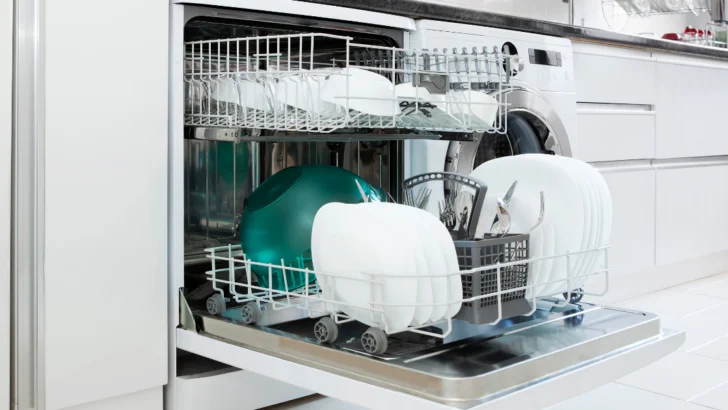
No Drain, No Gain – Tackling KitchenAid Dishwasher Woes
Navigating Types of Dishwasher Clogs: Causes and Effective Remedies
A well-functioning dishwasher is an unsung hero in the realm of kitchen appliances, effortlessly streamlining our post-meal cleanup routine. Yet, there are times when this stalwart companion encounters a hiccup, leaving us with a dilemma to address – a dishwasher that refuses to drain. Let’s embark on a journey to uncover the culprits behind this predicament and equip ourselves with solutions that reinstate the harmonious flow of our kitchen chores.
The Culprits: Types of Dishwasher Clogs
- Food Clogs: In the bustling rhythm of our lives, the remnants of our culinary adventures often find their way into the dishwasher without a second thought. Those forgotten food particles can eventually orchestrate a silent uprising within the dishwasher drain, leading to a troublesome blockage. The result? A dishwasher that is hesitant to complete its draining act.

From Clog to Flow – Resolving KitchenAid Dishwasher Drainage
Solution: Taming the Food Menace
To tame this food-driven rebellion, our first course of action involves a surgical intervention. Begin by delicately detaching the dishwasher drain basket and immersing it in a ritual of thorough cleansing. Here, persistence is key, as every morsel of leftover sustenance must be banished. Armed with a wire hanger, you delve into the drain’s depths, coaxing out any remnants that dared to challenge its flow.
A surge of hot water, akin to a cleansing river, is then introduced to flush away the remaining culinary rebels. This meticulously orchestrated act breathes life back into your dishwasher, restoring its draining prowess to its former glory.
- Grease Clogs: The aftermath of a sumptuous feast often leaves us with dishes carrying tales of grease-laden indulgence. These stories, while satisfying to our taste buds, can spell trouble for our dishwasher’s intricate system. Grease, much like a stealthy intruder, accumulates within the dishwasher drain, gradually crystallizing into a formidable clog that impedes the graceful exit of water.
Solution: Dissolving the Grease Enigma
Confronting this greasy conundrum requires a strategic approach. The dishwasher drain basket once again assumes center stage, its thorough cleansing pivotal in this endeavor. However, this time, a concoction of baking soda and vinegar steps into the limelight. Pouring this alchemical mixture down the drain triggers a process of dissolution, as the grease’s tenacious hold loosens its grip.
A brief interlude of 15 minutes allows this potent concoction to work its magic, eroding the once-impenetrable barrier. With anticipation, hot water cascades through the drain, executing a final flourish that eradicates the remnants of grease and ensures the dishwasher’s triumph over adversity.
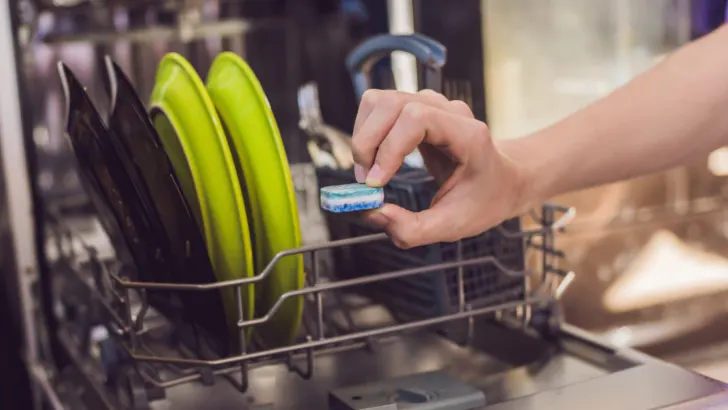
Unlocking the Drain – Diagnosing KitchenAid Dishwasher Issues
Beyond Clogs: The Road Less Traveled
Occasionally, the saga of a non-draining dishwasher unfolds due to deeper tribulations. A malfunctioning drain pump or a compromised drain hose could be the orchestrators of this stubborn rebellion. When the measures mentioned above fail to quell the turmoil, it’s a wise course of action to enlist the aid of a professional, an artisan well-versed in the intricate symphony of dishwasher mechanics.
Navigating the Intricacies of Dishwasher Clogs: A Path to Effortless Efficiency
As we embark on a journey through the realm of dishwasher maintenance, a gentle reminder emerges – prevention stands as the cornerstone of a hassle-free experience. Before ushering your dishes into the embrace of the dishwasher, a thoughtful ritual unfolds. It involves ensuring that remnants of meals past are banished, allowing your culinary companions to embark on their cleansing voyage unburdened. This conscientious act yields rewards beyond the immediate, safeguarding you from future encounters with the stubborn phenomenon known as dishwasher clogs. Moreover, it nurtures your dishwasher’s enduring commitment to operating at the pinnacle of efficiency, day in and day out.

Troubleshooting KitchenAid Dishwasher Drainage Challenges
In the dynamic choreography of kitchen stewardship, a deep understanding of the intricacies of dishwasher clogs grants you the authority to orchestrate swift resolutions. Armed with a wealth of insights and a toolkit of effective remedies, you assume the role of the master conductor, guiding the harmonious rhythm of your kitchen’s workings. Your expert touch ensures an unimpeded flow in every facet of your culinary journey, a dance of seamless transitions and unburdened functionality.
In a world where time is precious and efficiency is paramount, your conscientious approach to dishwasher care echoes far beyond the confines of your kitchen. It reflects a commitment to an optimized lifestyle, where even the seemingly mundane tasks are executed with finesse. As you navigate the labyrinth of dishwasher intricacies, remember that the power to ensure effortless efficiency lies within your grasp, transforming each culinary endeavor into a symphony of smooth operations and pristine outcomes.
Resources:
- Family Handyman (https://www.familyhandyman.com/)
- HomeAdvisor (https://www.homeadvisor.com/)
- Appliance Repair.com (https://www.appliancerepair.com/)
- Repair Clinic (https://www.repairclinic.com/)
- KitchenAid Support (https://www.kitchenaid.com/service-and-support.html)
Frequently Asked Questions
How do I troubleshoot my KitchenAid dishwasher if it’s not draining?
If your KitchenAid dishwasher is not draining, there are a few things you can do to troubleshoot the issue. First, check to see if there are any obstructions in the drain hose or the drain valve. You can also check the filter assembly at the bottom of the washtub for any blockages. Additionally, make sure that the garbage disposer knockout plug has been removed and that the drain hose is not kinked.
What are the most common causes of a KitchenAid dishwasher not draining?
There are several common causes of a KitchenAid dishwasher not draining. These include a clogged drain hose, a malfunctioning drain valve, a blocked filter assembly, or a faulty drain pump. Other potential causes include a clogged garbage disposer, a kinked drain hose, or a faulty float switch.
Where is the drain valve located on a KitchenAid dishwasher?
The drain valve on a KitchenAid dishwasher is typically located at the bottom of the washtub, near the drain hose. It is responsible for controlling the flow of water out of the dishwasher during the draining cycle.
What should I do if my KitchenAid dishwasher has standing water in the filter?
If your KitchenAid dishwasher has standing water in the filter, the first step is to remove any large food particles or debris. Next, check the filter assembly for any blockages or damage. If the filter is clogged or damaged, it may need to be replaced.
Are there any specific models of KitchenAid dishwashers that are known for drainage issues?
While drainage issues can occur with any model of KitchenAid dishwasher, some models may be more prone to these types of issues than others. If you are experiencing drainage problems with your dishwasher, it may be worth checking to see if there are any known issues or recalls for your specific model.
Is there a way to fix my older KitchenAid dishwasher if it’s not draining properly?
Yes, there are several ways to fix an older KitchenAid dishwasher if it’s not draining properly. First, check the drain hose and valve for any blockages or damage. You can also try cleaning the filter assembly or replacing the drain pump. If these steps do not resolve the issue, it may be time to consider replacing your dishwasher with a newer model.
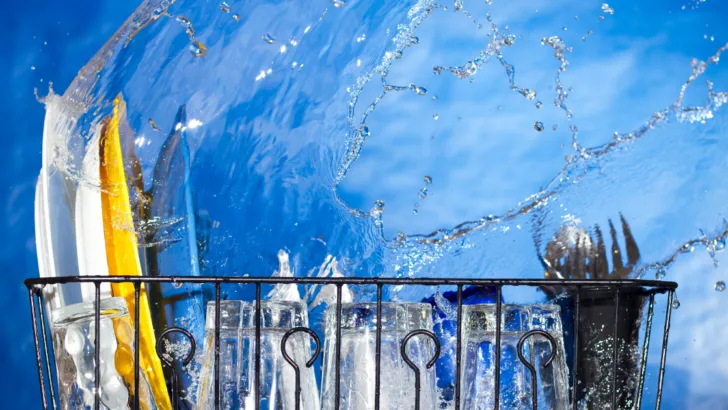
When Water Stands Still – KitchenAid Dishwasher Drainage Help

